Mazda 3 2015 Easy to Work on
2004-2009 Mazda 3: problems, engines, fuel economy, pros and cons, photos
Updated: February 26, 2020
The first-generation Mazda 3 is a fun-to-drive peppy compact, available as a sedan or hatchback. The Mazda 3 has front-wheel drive and sport-tuned independent suspension.
It rides on the same platform as the Ford Focus and Volvo S40.
The Mazda 3 comes with a 4 cylinder engine and a five-speed manual or four- or five-speed automatic transmission. Rear brakes are discs only. The interior is sporty tight, with supportive front seats. The steering tilts and telescopes. The glove box is big enough to hold a laptop computer. Mazda 3 is a simple car and is easy to work on. Parts are widely available and not very expensive.
Mazda 3 problems:
Front end and suspension problems: Rear shock absorbers can leak, causing the rear end of the car to feel 'loose' and bouncy on bumps. The top shock absorber mount can also break off at higher mileage. The shock mount could come separately or together with the shock absorber. Replacing rear shock absorbers is easy and not very expensive ($130-$170 per side). Front struts can leak too. Replacing front struts is a bit more expensive: $250-400 per side. Front lower control arms can also go bad at higher mileage. Replacing both front control arms costs $480-$620. The wheel alignment might need to be performed after the front struts or control arms are replaced.
Vibration in 'Drive': A vibration from the engine that is more noticeable at idle when the transmission is in Drive could be caused by a bad top engine mount.
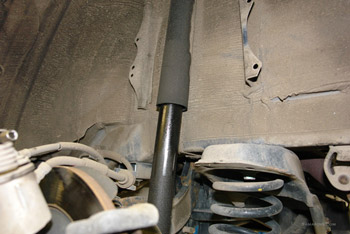 Leaking rear shock absorber
Leaking rear shock absorber
This part is very common to fail. Replacing the top engine mount could cost $160-$230.
The car doesn't start in Park but starts in Neutral: This issue could be caused by rust at the lever where the shifter cable connects to the transmission (front lower part of the transmission). The repair is very simple and inexpensive. The pivot point needs to be lubricated or the lever needs to be replaced.
The car won't start, the engine won't turn over: Check the battery first. If the battery is OK, a corroded connection at the starter control terminal can also cause this condition. If the control wire connector is corroded, the terminal needs to be cleaned and the wire connector needs to be replaced.
Check Engine light with the codes P0131 / P2251 : The Technical Service Bulletin 01-015/10 recommends checking the front air/fuel ratio harness where it rubs against the bracket. This photo shows where. If the harness is damaged, the TSB recommends replacing the A/F sensor. The bracket needs to be bent away from the harness.
A faulty transmission control module or TCM can cause the automatic transmission to shift harshly and the AT light to come on. The problem must be diagnosed properly and if it is caused by the issue with the TCM, it must be replaced. The TCM is easy to replace, but the part is quite expensive. An aftermarket TCM (part) is cheaper online, but the quality might not always be on par.
Engines: The Mazda 3 comes with a 148-hp 2.0-liter inline-4 (model LF) or a 156-hp 2.3-liter 4-cylinder engine, model L3. Both are solid, reliable DOHC engines. Both engines have been successfully used in many Ford, Mazda and other vehicles. With good maintenance, either engine can last over 250K miles. Timing chain or timing belt?
Fuel economy The EPA rates the 2004-2008 Mazda 3 with a 2.0-liter engine and automatic transmission at 23/31 mpg (10.2/7.6 L/100 km) city/highway.
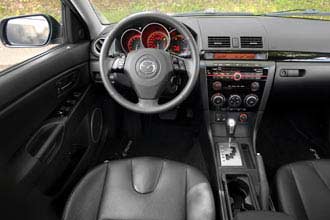 2009 Mazda 3 sedan interior.
2009 Mazda 3 sedan interior. 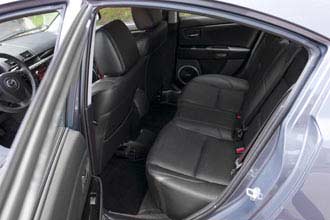 2009 Mazda 3 sedan.
2009 Mazda 3 sedan. 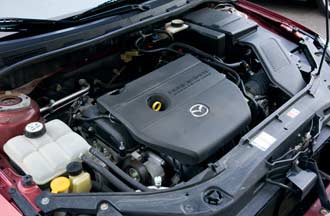 Mazda 3 engine
Mazda 3 engine
With this fuel consumption, the 2.0L Mazda 3 is expected to travel up to 405 miles, or 651 kilometers, on one 14.5-gallon (55 liter) tank. The 2007-2008 Mazda 3 with a 2.3L engine and automatic transmission gets 22/29 mpg (10.7/8.1 L/100 km).
Handling and ride: Thanks to its sporty suspension, the Mazda 3 feels lively on twisty roads and solid on the highway. The ride is firm but compliant. The steering is precise and responsive; the turning radius is small. Even the base 2.0L engine has plenty of power. On the downside, some road and tire noise is noticeable.
Mechanical: The Mazda 3 has independent suspension and disc brakes on all four wheels. The steering rack is hydraulic, but the steering pump is driven by an electric motor. Anti-lock brakes are available. Dynamic stability control (DSC), traction control, side and side curtain airbags are available on late models.
Pros: Fun to drive, sporty styling, practical interior, peppy engine, tight turning radius, available Bose audio system, large glove box.
Cons: Road noise, models without side airbags scored poorly in side impact crash tests, no trunk release on the remote, some interior materials are not of top quality (e.g. carpet), early models were prone to rust, questionable reliability.
Overall: The Mazda 3 is a sporty compact car. It handles well and has a solid reliable engine. Fuel economy is average for the class; if you want something more efficient, look for the Honda Civic or Toyota Corolla. The Toyota Corolla is also more reliable. Earlier Mazda 3 models were prone to rust. Later model years are better. The 2008 and 2009 model years are more reliable, but watch out for problems mentioned above. Read also: What mileage is OK for a used car?
Related reviews:
Toyota Corolla 1998-2008
Pontiac Vibe 2003-2010
Honda Civic 2006-2011
Mazda 3 2010-2013
Chevrolet Cruze 2011-2015
Toyota Corolla 2009-2013
What to look for when buying a used Mazda 3: Avoid the car if there is blue smoke coming from the exhaust or if the engine is too noisy.
Rust around the rear wheel wells is common. A small rust spot can be repaired, but major rust should be avoided. See if the struts and shock absorbers look dry. A leaking strut or shock absorber will need to be replaced.
Check the air conditioner. During the test drive, see if the car drives straight and doesn't drift. See if the transmission shifts smoothly. Avoid the car if the "AT" or "Check Engine" light stays on, as some problems could be expensive to repair. A failed TCM (Transmission Control Module) can cause the transmission to jerk and the "AT" and "Check Engine" light to come on. The part is expensive.
Watch out for tire noise; if not rotated regularly, rear tires tend to wear unevenly, which may result in a noisy ride. If the engine vibration is felt with the shifter in Drive, the top engine mount could be bad, although it's not very expensive.
Mazda 3 Maintenance tips:
Some high-mileage Mazda 3 engines are known to consume oil. Check the oil level regularly. Change transmission fluid when it becomes dirty. If you don't know when transmission fluid was changed last time, you can check it on the dipstick (see the photo).
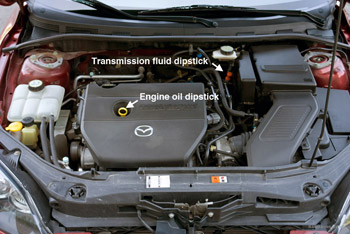 2004-2009 Mazda 3 dipstick location
2004-2009 Mazda 3 dipstick location
If it looks red and clean, it's OK; if it's dark, it's better to change it. Mazda 3 has an independent rear suspension for better handling, however with this design, the rear tires wear more on the inside. If you want your tires to last longer, rotate them often. The owner's manual for 2007 Mazda 3 recommends rotating tires every 7,500 miles (12,000 km) in normal driving conditions. Tires are rotated front to back, on the same side. Without regular rotation, rear tires often become cupped, which will result in noisy ride.
Price for common maintenance items:
Oil change, tire rotation: $45-60. Transmission fluid flush: $150-200. Drive belt replacement: $120-160. Front brake replacement (pads and rotors): $310-430. Wheel alignment: $90-130.
Source: https://www.samarins.com/reviews/mazda3.html
0 Response to "Mazda 3 2015 Easy to Work on"
Post a Comment